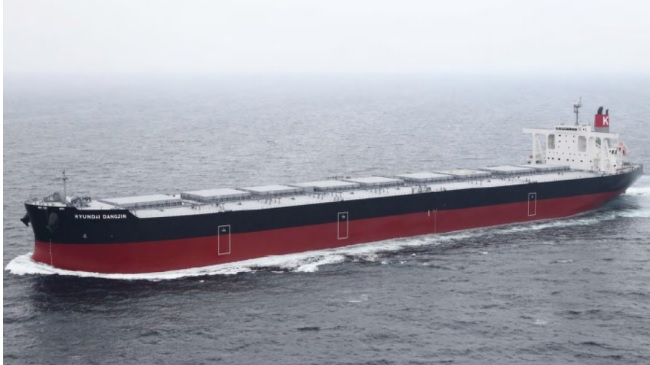ATSB has issued Transport Safety Report regarding crew fatality onboard Hyundai Dangjin on July 10, 2015. According to the report, in the early hours of the accident, the vessel was in the final stages of loading its cargo of iron ore at Port Walcott, Western Australia. The ship was starboard side alongside the wharf and the chief mate and draught surveyor were on the wharf to check the ship’s draught. They could see the forward and aft draught marks but not the midships marks.
At 0450, 1 the chief mate asked the second mate, via UHF radio, to read the midships draught on the ship’s port (outboard) side. The ship’s crew had already rigged a rope ladder (Figure 1) adjacent to the draught marks there.
In preparation to climb down the rope ladder, the second mate donned a life vest (non-inflatable flotation aid). The able seaman (AB) on duty offered to go down the ladder instead of the second mate, who was a large and heavy man. The second mate declined the AB’s offer (mates are trained to read draught marks)
Just after 0455, the chief mate and draught surveyor returned from the wharf to the ship’s office. The chief mate then called the second mate and asked for the midships draught. The second mate did not reply.
At that time, the second mate was near the bottom of the ladder, about 7 m below the ship’s deck. He called out to the AB for help and said he was having difficulty. When the AB checked, he saw the second mate struggling to hold on to the ladder. As the AB looked around for a rope to throw down, the second mate fell into the water. The AB threw a nearby lifebuoy to the second mate and it landed a few metres away.
The second mate tried to swim to the lifebuoy, but was not able to reach it. The sea was rough (1.4 m sea on a 0.4 m swell) and the water temperature was about 22 °C
Rescue attempts
At about 0458, the AB called the third mate on the radio and told him that the second mate had fallen into the water. The AB then climbed down the ladder and entered the water. At this time, the second mate was about 4 m from the ladder and drifting further away. The AB had difficulty breathing and swimming in the rough, cold seawater. He was unable to reach the second mate and returned to the ladder.
The third mate reported the man overboard to the chief mate, before hurrying to the rope ladder. When he arrived there, he saw the second mate about 20 m from the ladder. His arms were moving slowly and he was not getting any closer to the lifebuoy about 3 m away. The third mate then went aft to get a lifebuoy with a lifeline attached
ATSB comment
The rope ladder had been rigged upside down (Figure 1). With their wrong side up, the ladder steps (folded aluminium) did not provide a flat surface to stand on comfortably. Further, the steps were not good handholds. The sole precaution taken by the second mate while reading the draught marks was his life vest. No fall prevention measures were put in place or used.
The life vest’s specifications could not be determined but similar types provide around 7 to 10 kg of buoyancy. While the AB was standing by on deck, man overboard response measures (such as a lifebuoy with light and line near the ladder) were not in place. Fortunately, his well-intentioned but impulsive descent of the ladder in an attempt to rescue the second mate did not result in another casualty. The second mate’s initial post mortem examination report stated the cause of death as ‘undetermined (pending further investigation)’.
However, the report noted that some findings of the examination ‘could be seen with drowning’. The report stated that the body was of a man of large build and included his height and weight. This is consistent with the attending police officer’s report, which noted that the second mate ‘was a man of large overweight build’.
Learn more
Source: ATSB






























































